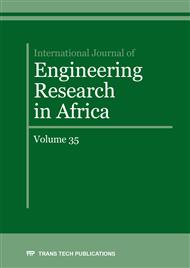[1]
Aase (2002), Perspectives of risk sharing, Scandinavian Actuarial Journal, Vol 2, (2002).
Google Scholar
[2]
Acerbi & al (2002), On the Coherence of Expected Shortfall, Journal of Banking and Finance Vol 26, Iss 7.
Google Scholar
[3]
Andreani, Birgin, Martínez, & Schuverdt (2007), On augmented Lagrangian methods with general lower-level constraint,. SIAM Journal on Optimization, 18, 1286–1302.
DOI: 10.1137/060654797
Google Scholar
[4]
Artzner & Delbaen (1997), Definition of coherent measures of risk, European Finance Association, Symposium August 27-30.
Google Scholar
[5]
Artzner (1999), Application of coherent risk measures to capital requirements in insurance, North American Actuarial Journal, April 1999 Vol 3, N°2.
DOI: 10.1080/10920277.1999.10595795
Google Scholar
[6]
Balbas & al (2009), Optimal reinsurance with general risk measures, Insurance: Mathematics and Economics 44.
Google Scholar
[7]
Ben Dbabis (2013), Modèles et méthodes actuarielles pour l'évaluation quantitative des risques en environnement Solvabilité II, Thèse de doctorat, Université Paris Dauphine.
Google Scholar
[8]
Birgin, Castillo, & Martínez (2005), Numerical comparison of augmented Lagrangian algorithms for nonconvex problems, Computational Optimization and Applications, 31.
DOI: 10.1007/s10589-005-1066-7
Google Scholar
[9]
Blazenko (1985), Optimal insurance policies, Insurance: Mathematics and Economics, Vol 4, (1985).
Google Scholar
[10]
Borch (1960), An attempt to determine the optimum amount of Stop loss reinsurance, Transactions of the 16th International Congress of Actuaries, 597-610.
Google Scholar
[11]
Cai & Tan (2007), Optimal Retention for a Stop loss Reinsurance Under the VaR and CTE Risk Measures, Astin Bulletin (2007).
DOI: 10.2143/ast.37.1.2020800
Google Scholar
[12]
Cantu Paz (2000), Efficient and Accurate Parallel Genetic Algorithms, Kluwer Academic Publishers.
Google Scholar
[13]
Centeno (2002a), Excess of loss reinsurance and gerber's inequality in the sparre Anderson model, Insurance: Mathematics and Economics 31.
DOI: 10.1016/s0167-6687(02)00187-7
Google Scholar
[14]
Centeno (2002b), Measuring the effects of reinsurance by the adjustment coeffcient in the sparre anderson model, Insurance: Mathematics and Economics 30, 37.
DOI: 10.1016/s0167-6687(01)00095-6
Google Scholar
[15]
Centeno (2005), Dependent risks and Excess of loss reinsurance, Insurance: Mathematics and Economics 37.
DOI: 10.1016/j.insmatheco.2004.12.001
Google Scholar
[16]
Davis. L. (1991), The genetic Algorithm Handbook, Ed. New- York: Van Nostrand Reinhold, ch.17.
Google Scholar
[17]
Daykin & Pesonen (1994), Practical Risk Theory for Actuaries, Chapman & Hall, London.
Google Scholar
[18]
Deestra & Plantin (2004), La réassurance, Economica, (2004).
Google Scholar
[19]
Denault, M. (2001), Coherent Allocation of Risk Capital, Journal of Risk 4, 1-34.
Google Scholar
[20]
Denuit (2004), Charpentier, Mathématiques de l'assurance non vie, tome 1 : Principes fondamentaux de théorie du risque. Economica (2004).
Google Scholar
[21]
Dickson (1992), On the distribution of surplus prior to ruin, Insurance: Mathematics and Economics 11.
DOI: 10.1016/0167-6687(92)90026-8
Google Scholar
[22]
Emiliano & Valdez (2004), On Tail Conditional Variance and Tail Covariances, Faculty of Commerce & Economics, The University of New South Wales Sydney, AUSTRALIA (2052).
Google Scholar
[23]
Enteno (2002b), Measuring the effects of reinsurance by the adjustment coefficient in the sparre anderson model, Insurance: Mathematics and Economics 30, 37-49.
DOI: 10.1016/s0167-6687(01)00095-6
Google Scholar
[24]
Goldberg (1989), Genetic Algorithms in search, optimization and Machine learning, Addison-Wesley.
Google Scholar
[25]
Grandell (1991), Aspects of Risk Theory, Springer - Verlag, New York.
Google Scholar
[26]
Hancock, Huber & Koch (2001), Value Creation in the Insurance Industry, Risk Management and Insurance Review 4, 1-9.
DOI: 10.1111/1098-1616.00001
Google Scholar
[27]
Hess (2000), Méthodes actuarielles de l'assurance vie, Economica.
Google Scholar
[28]
Ignatove, Kaishev & Krachunov (2004), Optimal retention levels, given the joint survival of cedent and reinsurer, Scandinavian Actuarial Journal 6, (2004).
DOI: 10.1080/03461230410020437
Google Scholar
[29]
K.S Tan, C.Weng & Y. Zhang (2011), Optimality of general reinsurance contracts under CTE risk measure, Insurance: Mathematics and Economics, 49(2), 175–187.
DOI: 10.1016/j.insmatheco.2011.03.002
Google Scholar
[30]
K.S. Tan & Chi, Y (2011), Optimal reinsurance under VaR and CVaR risk measures: A simplified approach, ASTIN Bulletin, 41(2), 487-509.
Google Scholar
[31]
Kaas & al (2001), Modern Actuarial Risk Theory, Boston, Dordrecht, London, Kluwer Academic Publishers 28.
Google Scholar
[32]
Kaas, Goovaerts, Dhaene & Denuit (2001), Modern Actuarial Risk Theory, Klawer, Boston.
DOI: 10.1007/978-3-540-70998-5
Google Scholar
[33]
Kleiber, Kotz (2003), Statistical Size Distributions in Economics and Actuarial Sciences, New Jersey: John Wiley & Sons, Inc.
DOI: 10.1002/0471457175
Google Scholar
[34]
Landsman, Emiliano & Valdez (2004), Tail Conditional Expectations for Exponential Dispersion Models, University of New South Wales, Sydney, AUSTRALIA , February (2004).
Google Scholar
[35]
Liang Hong & Ahmed Elshahat (2011), Conditionnal Tail Variance and Conditionnal Tail Skewness in Finance and Insurance, Bradley University.
Google Scholar
[36]
Lutton (1999), Algorithmes génétiques et Fractales, Dossier d'habilitation à diriger des recherches, Université Paris XI Orsay, 11 Février (1999).
Google Scholar
[37]
Mathieu Boudreault (2010), Mathématiques du risque, Document de référence, Département de mathématiques, Université du Québec à Montréal.
Google Scholar
[38]
Panjer (2002), Measurement of Risk, Solvency Requirements, and Allocation of Capital within Financial Conglomerates, Research Report 01-14. Institute of Insurance and Pension Research, University of Waterloo, Canada.
Google Scholar
[39]
Patrick (2004), Reinsurance, Encyclopedia of Actuarial Science, Wiley, 1400-1403.
Google Scholar
[40]
Petauton, Kessler & Bellando (2002), Théorie et pratique de l'assurance vie : manuel et exercices corrigés, Dunod.
Google Scholar
[41]
Renders (1995), Algorithmes génétiques et Réseaux de Neurones, Editions HERMES.
Google Scholar
[42]
Rockafellar & Uryasev (2000), Optimization of conditional value-at-risk, Journal of Risk, 2, 21-42.
Google Scholar
[43]
Rytgaard (2004), Stop loss reinsurance, Encyclopedia of Actuarial Science, Wiley.
DOI: 10.1002/9780470012505.tas037
Google Scholar
[44]
S. Amédée & R. Francois (2004), Algorithme génétique, TE de fin d'année Tutorat de Philippe Audebaud.
Google Scholar
[45]
Walhin & Lampaert (2005), On the Optimality of Proportional Reinsurance, Scandinavian Actuarial Journal, vol 3, (2005).
DOI: 10.1080/03461230510009781
Google Scholar
[46]
Zinoviy Landsman (2014), Tail risk measures for Generalized Skew - Elliptical distributions, 8th Conference in Actuarial Science & Finance on Samos.
Google Scholar


